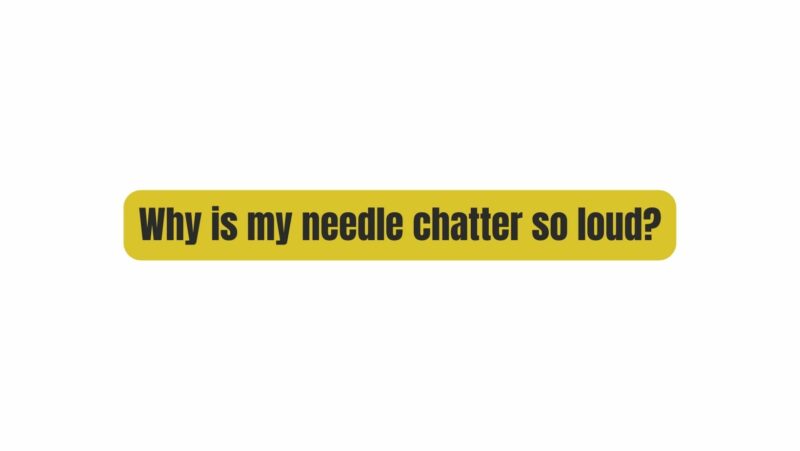The incessant clatter of a needle can be an irritating disturbance in various scenarios, whether it’s a sewing machine, a record player, or even a medical device. Why does this happen, and what can be done to reduce the noise? In this article, we will delve into the mechanisms behind loud needle chatter and offer solutions to mitigate it.
Understanding the Basics
Before we dive into specific contexts, it’s essential to grasp the fundamental principles that cause needles to make noise. A needle’s chattering sound can be attributed to several factors, including vibration, friction, and the material it interacts with.
1. Vibration:
Vibration is a primary contributor to needle chatter. When a needle moves rapidly, it generates vibrations, which then propagate through the surrounding materials and the air. These vibrations produce sound waves, resulting in the characteristic noise we hear.
2. Friction:
Friction between the needle and the material it’s penetrating can also lead to noise. As the needle slides or punctures the material, it encounters resistance, causing friction. This friction generates noise, which can vary in intensity depending on the materials involved.
3. Material Interaction:
The type of material being pierced by the needle plays a significant role in the noise level. Some materials are inherently noisier than others when pierced by a needle. The density, texture, and composition of the material can all influence the sound produced.
Now, let’s explore various scenarios where needle chatter can become particularly noticeable and bothersome.
Sewing Machine Needles
Causes of Loud Needle Chatter:
Sewing machines are a common source of loud needle chatter. Several factors can contribute to this issue:
a. Needle Type and Quality:
The type and quality of the needle you use in your sewing machine can significantly impact noise levels. Dull or low-quality needles tend to produce more noise because they encounter more resistance as they move through the fabric.
b. Thread Tension:
Incorrect thread tension can lead to excessive noise. When the thread tension is too tight or too loose, it can cause the fabric to vibrate, amplifying the noise generated by the needle.
c. Machine Maintenance:
A poorly maintained sewing machine can be noisier than a well-maintained one. Regular cleaning and lubrication of your machine can reduce friction and minimize noise.
Solutions to Reduce Sewing Machine Needle Chatter:
To reduce the noise generated by a sewing machine needle, consider the following solutions:
- Use high-quality, sharp needles designed for your specific fabric.
- Adjust the thread tension according to the manufacturer’s recommendations.
- Keep your sewing machine well-maintained by cleaning and oiling it regularly.
- Consider using a noise-dampening mat or pad beneath your sewing machine to absorb vibrations.
Record Player Needles
Causes of Loud Needle Chatter:
Record players, particularly vintage models, are notorious for their needle chatter. This noise can be caused by various factors:
a. Record Condition:
The condition of your vinyl records plays a significant role in needle noise. Scratched or warped records can cause the needle to jump and skip, producing loud and unpleasant sounds.
b. Tracking Force:
The tracking force, or the weight applied by the tonearm to the stylus, can affect needle chatter. Too much or too little tracking force can lead to unwanted noise.
c. Needle Wear:
Worn-out or damaged needles can cause excessive chatter. It’s essential to regularly replace the stylus to maintain optimal playback quality.
Solutions to Reduce Record Player Needle Chatter:
To enjoy smooth, quiet playback on your record player, consider these solutions:
- Ensure your vinyl records are clean and in good condition.
- Adjust the tracking force according to the manufacturer’s recommendations.
- Replace the stylus when it shows signs of wear.
- Invest in a quality turntable with vibration-dampening features.
Medical Device Needles
Causes of Loud Needle Chatter:
In medical settings, particularly during injections and procedures, needle chatter can be a source of patient anxiety and discomfort. The following factors contribute to this noise:
a. Needle Material:
The material of the needle itself can influence noise levels. Stainless steel needles are commonly used in medical devices and tend to be quieter than other materials.
b. Needle Size:
Smaller needles often produce less noise than larger ones because they encounter less resistance when puncturing tissue.
c. Injection Technique:
The speed and angle at which a needle is inserted can impact noise levels. Rapid or abrupt insertions are more likely to produce noise.
Solutions to Reduce Medical Device Needle Chatter:
To minimize patient discomfort and anxiety related to needle chatter in medical settings, consider the following solutions:
- Choose high-quality, stainless steel needles.
- Use smaller-gauge needles when possible.
- Train healthcare professionals in proper injection techniques to minimize noise.
- Communicate with patients to alleviate anxiety and provide reassurance during procedures.
Conclusion
In various scenarios, from sewing machines to record players to medical devices, the loud chatter of a needle can be a bothersome issue. However, understanding the underlying causes of needle noise and implementing appropriate solutions can help mitigate this problem. Whether it’s using the right needle, adjusting machine settings, or maintaining equipment properly, taking proactive steps can make a significant difference in reducing the annoying clatter of needles in our lives.


